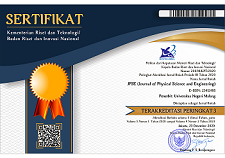An Analysis of Energy Production of Rooftop on Grid Solar Power Plant on A Government Building (A Case Study of Setjen KESDM Building Jakarta)
Abstract
In producing electrical energy, the solar module is affected by some factors, such as the solar radiation intensity, temperature, orientation and slope of the module, and shading that occurs during operation. The solar power plant of Setjen KESDM is coordinated at 6°10’53.73” south latitude and 106°49’24.61” east longitude, with a slope of 9.7°–10.0° and azimuth of -2.0° to -5.0° towards the north. It consists of five placement locations, including 11th floor rooftop, T1, T2, T3, and L carports with a total capacity of 150 kWp. The analysis of the production of rooftop on grid solar power plant in the government building with a case study in the Setjen KESDM was intended to determine the level of production of the solar power plant built and the parameters that influence it, which was conducted by comparing the real results with the simulation results using SAM software. The energy production in 2017 was 118,259.3 kWh, in 2018 was 106,318.3 kWh, and in 2019 was 109,973.0 kWh. The highest production was obtained in September, October, and March every year due to the maximum solar radiation. The solar power plant on the 11th floor rooftop was more maximal in producing energy for all positions of the sun than the solar power plant on the T1, T2, T3, and L carports because it was free of shading from buildings and trees. The output produced by the solar power plant of Setjen KESDM could not reach the maximum point because the location temperature was higher than the standard test conditions of the solar module.
Keywords
Full Text:
PDFReferences
J. Widodo, “Rencana Umum Energi Nasional Republik Indonesia” in Peraturan Presiden Republik Indonesia Nomor 22 Tahun 2017, Jakarta: Kementerian Sekretariat Negara, 2017.
H. Asrofi, “Penggunaan Sistem Pembangkit Listrik Tenaga Surya Atap oleh Konsumen PT Perusahaan Listrik Negara (Persero),” in Peraturan Menteri ESDM Nomor 49 Tahun 2018, Jakarta: Kementerian Energi dan Sumber Daya Mineral, 2018.
S. Hamdi, “Mengenal Lama Penyinaran Matahari sebagai Salah Satu Parameter Klimatologi, Peneliti Pusat Sains dan Teknologi Atmosfer,” Berita Dirgantara Lapan, vol. 15, no. 1, pp. 7–15, 2014.
I. K. A. Setiawan, W. Sukerayasa, and I. N. S. Kumara, “Analisis Unjuk Kerja Pembangkit Listrik Tenaga Surya (PLTS) Satu MWP Terinterkoneksi Jaringan di Kayubihi,” Majalah Ilmiah Tekno. Elek., vol. 13, no. 1, 2014.
B. Rosengren, Technical Application Papers No. 10 Photovoltaic Plants, Zürich: ABB Group, 2010.
J. A. Duffie and W. A. Beckman, Solar Engineering of Thermal Processes, 4th ed., Madison: Wiley, 2013.
V. Quaschning, Understanding Renewable Energy System, London: Earthscan, 2012.
E. T. Hashim and A. A. Abbood, “Temperature Effect on Power Drop of Different Photovoltaic Modules,” J. Eng., vol. 22, no. 5, pp. 129–143, 2016.
N. O. Arinze and M. E. Farrag, “Analysis of PV Modules Performance in Nigeria: A Guide for Suitable System Design and Module Specifications Selection,” Int. J. Research Eng. and Sci. (IJRES), vol. 6, no. 7, pp. 01–13, 2018.
K. H. Khwee, “Pengaruh Temperatur terhadap Kapasitas Daya Panel Surya (Studi Kasus: Pontianak),” J. Tek. Elek. ELKHA, vol. 5, no. 2, pp. 23–26, 2013.
J. Adeeb, A. Farhan, and A. Al-Salaymeh, “Temperature Effect on Performance of Different Solar Cell Technologies,” J. Ecol. Eng., vol. 20, no. 5, pp. 249–254, 2019.
Q. M. Aish, “Temperature Effect on Photovoltaic Modules Power Drop,” Al-Khwarizmi Eng. J., vol. 11, no. 2, pp. 62–73, 2015.
J. A. del-Cueto, PV Module Energy Ratings Part II: Feasibility of Using the PERT in Deriving Photovoltaic Module Energy Ratings, Golden: National Renewable Energy Laboratory, 2007.
D. Myers, “Evaluation of the Performance of the PVUSA Rating Methodology Applied to Dual Junction PV Technology,” in Ameri. Solar Energy Society Ann. Conf., New York: National Renewable Energy Laboratory, pp. 1–11, 2009.
S. Dubey, J. N. Sarvaiya, and B. Seshadri, “Temperature Dependent Photovoltaic (PV) Efficiency and Its Effect on PV Production in the World - A Review,” Energy Procedia, vol. 33, pp. 311–321, 2013.
J. Amajama and S. E. Mopta, “Effect of Air temperature on the Output of Photovoltaic Panels and Its Relationship with Solar Illuminance/Intensity,” Int. J. Sci. Eng. App. Sci. (IJSEAS), vol. 2, no. 8, pp. 161–166, 2016.
E. A. Handoyo, D. Ichsani, and Prabowo, “The Optimal Tilt Angle of A Solar Collector,” Energy Procedia, vol. 32, pp. 166–175, 2013.
A. Rachman, “Optimalisasi Teknologi Energi Surya Berbasis Penyesuaian Posisi Panel Bulanan di Sulawesi Tenggara,” J. Tekno., vol. 8, no. 1, pp. 1–8, 2016.
Y. S. Khoo et al., “Optimal Orientation and Tilt Angle for Maximizing In-Plane Solar Irradiation for PV Applications in Singapore,” IEEE J. Photovoltaics, vol. 4, no. 2, pp. 647–653, 2014.
E. E. Ekpenyong and F. I. Anyasi, “Effect of Shading on Photovoltaic Cell,” IOSR J. Elec. Electro. Eng., vol. 8, no. 2, pp. 1–6, 2013.
A. Djalab et al., “Study of the Effects of Partial Shading on PV Array,” in Int. Conf. Comp. Elect. Eng. (ICCEE), Tokyo: ICCEE, pp. 1–5, 2018.
F. Salem and M. A. Awadallah, “Detection and Assessment of Partial Shading in Photovoltaic Arrays,” J. Elec. Sys. Info. Techno., vol. 3, no. 1, pp. 23–32, 2016.
J. C. Teo et al., “Impact of Partial Shading on the P-V Characteristics and the Maximum Power of A Photovoltaic String,” Energies, vol. 11, no. 7, p. 1860, 2018.
Copyright (c) 2020 Zulkifli, Wahyu Wilopo, Mohammad Kholid Ridwan

This work is licensed under a Creative Commons Attribution-ShareAlike 4.0 International License.
This work is licensed under a Creative Commons Attribution-ShareAlike 4.0 International License



















